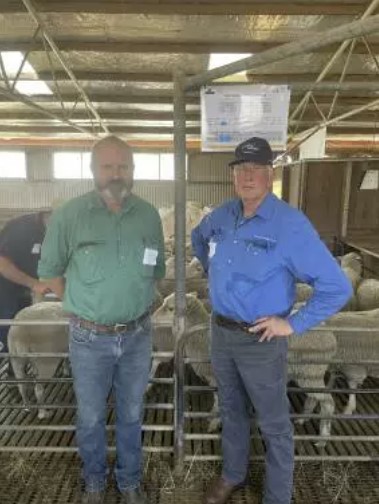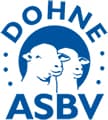Udders can and should be scored
Article courtesy of The Land By Stephen Burns

Allan Casey with a selection of Dohne ewes which were part of the sire evaluation trials held on Coonong Station, Urana.
Lamb mortality has an enormous impact on the sheep breeding industry, worth an estimated $840 million per annum in lost production, according to Allan Casey, a sheep breeding consultant based in Orange.
Mr Casey was addressing the recent Dohne Sire Evaluation field day held at Coonong Station, Urana, where his presentation was an outline on the research around udders and their effect on reproduction performance through survival and through growth of the lambs.
His delivery was based on the research which was largely done on the Merino Lifetime Production (MLP) site Chiswick, Armidale by Erin Smith and her colleagues. Evaluation is also being done on Coonong Station in conjunction with the Dohne Sire Evaluation trials that have been conducted.
“It is not just udder scoring data but understanding all of the relationships it has with other traits,” he said.
“Neonatal lamb mortality is the most significant health issue in sheep, and I think sheep producers can just take it for granted and not fully understand the impact it has on the enterprise performance.
“It’s in play all the time and I think we can just put up with it rather than work hard to understand it.”
Mr Casey said the economic cost was significant to individual producers, but the welfare issue of lamb loss has broader social implications.
“Our licence to operate sheep businesses depends very much on that and we can’t take that for granted,” he said.
“Lamb mortality also impedes breeding improvement – that’s not only to do with improving udders but also breeding improvement in our flocks through all the traits we are selecting for.
“Because without a large number of progeny it’s not possible to make the selections you need to make gains in other traits.”
Neonatal mortality has a major impact where starving and mismothering due to impaired udders accounts for 40pc of lamb loss while another 40pc is due to dystocia
“It has been found through the Chiswick research that udder conformation contributes significantly to the effect of starving and mismothering, dystocia complex,” Mr Casey said.
“Defects in udders contribute to around a doubling of mortalities – a significant factor.”
Udder and teat issues can be broken into two groups, which Mr Casey said are soundness and conformation.
“Soundness tends to be the things we look at – injuries, cuts, mastitis and malformation,” he said.
“Conformation, udder and teat shape, hasn’t been ignored in the past but it hasn’t really been understood effectively.”
How can sheep producers more easily identify the correct soundness and conformation of udders?
Mr Casey pointed to practices in the past where a ewe was culled and removed from the breeding flock due to a cut, blind or inverted teats or mastitis.
“They weren’t anything to do with the breeding of the sheep, but were considered a ‘one off’ action.

Jason Southwell, Orange, accredited Dohne sheep classer, with Allan Casey, Advanced Breeding Services, Orange, during the sire evaluation field day at Coonong Station, Urana.
“But we should be identifying them much better than the ‘quick feel’, because a lot of those effects don’t show up with a quick feel – they really need to be observed.
“A lot of teat cuts, for example, are quite superficial when looking at them from a distance or feeling the udder but in the end they are not allowing milk to flow through that teat.” Mr Casey said there is an immediate return through removing those inefficient ewes.
“From a ram breeders point of view we have a lot better data on reproductive performance. If we have ewes in the system that are not able to rear a lamb because of an injury to their teats, then we are misunderstanding the reproductive genes of the sheep because they’ve got impediments to expressing them – it is not their fault,” he said.
Mr Casey said udder scores have been developed through the Chiswick research looking at visual and measured evaluation of the traits to understand which were the important traits and which ones could be accurately assessed.
“It is based on a lot of solid research,” he said.
“There are three traits in the scoring system – udder depth, teat size and teat placement that can be evaluated through the scoring system and these are highly correlated with actually measuring the udders.
“You only need to score sheep that have had a lamb in that cycle and indicate the age of the sheep and the stage of the reproduction cycle as they are being evaluated.
“They can be scored during lambing or right through to weaning.”
Mr Casey said udder selection is a moderately heritable trait with a similar heritability to body weight and growth.
“Research has shown you need to do the assessment in a standing position,” he said.
“You do need to have a proper look and not just when the ewe is turned over.
“The standing position is best because a trait like udder depth is very hard to assess once you’ve turned her over.
“In conclusion we can measure and score these traits which are variable and heritable, so breeding gain can be made through using them.
“We know the correlations between these different traits and thus how they affect other traits.
“If we don’t have more impact in this area, we are going to have more lamb mortality and giving up a significant gain in weight
“So understanding these traits is important and how they can be scored at a range of ages.”










 Facebook
Facebook YouTube
YouTube Instagram
Instagram